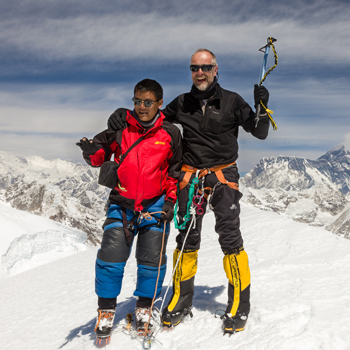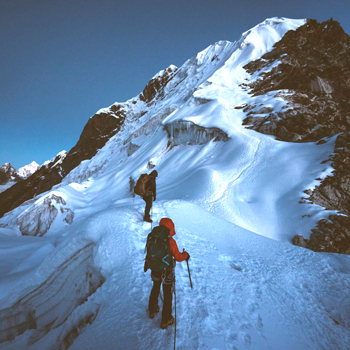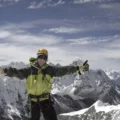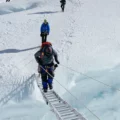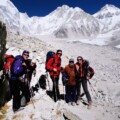Island Peak, which reaches a height of 6,189 meters (20,305 feet), is among Nepal’s most favored trekking peaks. Nestled in the Khumbu region near Mount Everest, it offers an exciting challenge for climbers and trekkers. The best time to climb Island Peak is essential for a successful ascent, as the weather and climbing conditions can significantly impact the overall experience.
Located close to the famous Everest Base Camp, Island Peak provides climbers with breathtaking views of surrounding giants such as Lhotse, Nuptse, and Ama Dablam. The peak is renowned for its stunning vistas and as a training climb for those aiming for higher summits like Mount Everest. It’s an excellent opportunity for adventure seekers to experience climbing in the Himalayas without the technical demands of more challenging peaks.
Island Peak is often included as an extension to the Everest Base Camp trek, attracting both seasoned mountaineers and trekkers looking to push their limits. The climb requires basic mountaineering skills and acclimatization, making it accessible to individuals passionate about high-altitude adventure. Understanding the best time to climb Island Peak can help maximize safety and enjoyment during the expedition.
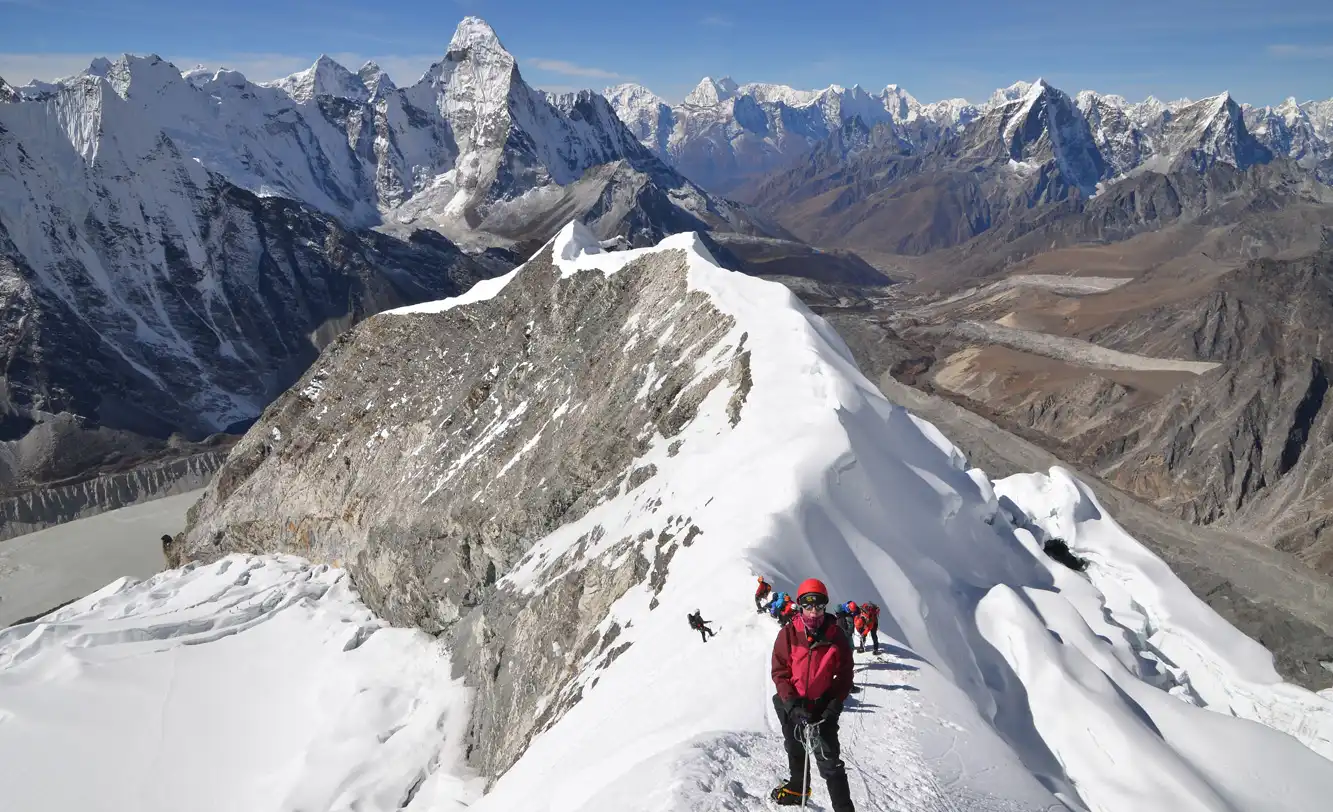
Best Seasons for Climbing Island Peak
The best time to climb Island Peak falls into two main seasons: spring and autumn. These periods offer excellent weather conditions and stable environments for trekking, making them popular with mountaineers. Here’s a closer look at each season and what you can expect:
Spring (March to May)
- Warmer Temperatures: Spring delivers pleasant weather, with mild temperatures during the day and colder, yet manageable, nights. Trekkers who prefer milder conditions find this season ideal for climbing Island Peak.
- Stable Climbing Conditions: Snow and ice are more stable in the spring. The spring’s stable snow and ice conditions create more accessible climbing routes, making the ascent more predictable. Many climbers opt for this season because of the safe and reliable conditions it offers.
- Blooming Scenery: The Khumbu region bursts into color during spring. Rhododendrons and other vibrant flowers line the trekking routes, enhancing the scenic beauty of the hike and adding to the overall experience.
- Clear Morning Skies: Spring often brings clear skies, especially in the morning. The clear skies and high vantage points offer an ideal setting for stunning views of peaks like Everest, Lhotse, and Ama Dablam. The visibility is perfect for photographers and nature lovers who want to capture breathtaking landscapes.
- High Popularity Among Climbers: The favorable weather and spectacular scenery make spring a busy time on Island Peak. Many climbers take advantage of the conditions, making the trail lively and social.
Autumn (September to November)
- Crisp, Clear Weather: Autumn brings crisp air and clear skies, especially after the monsoon season. This time of year is one of the most favorable for climbing Island Peak, as the dry conditions make trekking more comfortable and predictable.
- Low Rainfall: After the heavy rains of the monsoon end in August, September brings dry weather with little to no rainfall. Autumn is an ideal time to visit the Himalayas, providing better trekking conditions and improved visibility.
- Breathtaking Mountain Views: The mountain views are stunning, and the air is clear post-monsoon. You can enjoy panoramic vistas of Island Peak, Everest, and other nearby peaks. The fresh greenery contrasts beautifully with the snow-capped mountains under bright blue skies.
- Fewer Crowds: Autumn is a popular climbing season, but it generally attracts fewer trekkers than spring. Visiting during this time allows for a quieter, more peaceful experience while enjoying optimal weather.
- Stable Weather Conditions: Autumn offers steady and predictable weather with minimal disruptions. This season provides one of the safest environments for climbing, ensuring a smoother and more enjoyable adventure.

Monsoon Season (June to August)
The monsoon season, lasting from June to August, is generally considered the least favorable, as the best time to climb Island Peak lies outside of these months due to challenging conditions. Several challenges during this period make the ascent more complex and potentially hazardous. If you’re considering climbing during the monsoon, here are a few crucial factors to remember.
Heavy Rainfall
Nepal’s mountainous regions experience significant rainfall during the monsoon. These downpours turn the trails into muddy, waterlogged paths, making it hard to maintain a steady pace. In addition to slowing you down, the continuous rain limits visibility, reducing your chances of seeing the incredible views of Island Peak. Wet conditions also add to the discomfort, as clothes, gear, and tents often become damp despite your best efforts to stay dry.
Slippery Trails
The trails leading to Island Peak become particularly treacherous when wet. Constant rain makes the paths slippery, making trekking and climbing difficult. Wet rocks and muddy terrain increase the chances of slipping, which makes progress slow and safety a top priority. Extra care is needed when navigating these slippery surfaces, which adds to the challenge of reaching the summit during the monsoon season.
Risk of Landslides and Avalanches
Climbing Island Peak during the monsoon season also comes with the heightened risk of landslides and avalanches. Heavy rain weakens the soil and rocks, making landslides more likely. Higher up, snow accumulation becomes unstable, increasing the chance of avalanches triggered by wet conditions. These natural dangers pose serious threats, turning the monsoon into one of the riskiest times for a climb.

Winter Season (December to February)
Climbing Island Peak during the winter season, which spans from December to February, brings unique challenges. However, winter may appeal to seasoned climbers seeking solitude and a more adventurous experience. Here’s a detailed look at what to expect when climbing Island Peak in winter.
Challenges of Winter Climbing
- Extremely Cold Temperatures: Winter temperatures can drop dramatically, especially at higher altitudes. During the day, the cold can be manageable with the right gear, but nighttime temperatures often fall below freezing. Climbers must be prepared for harsh conditions, with high-quality cold-weather clothing and gear essential for survival and comfort.
- Heavy Snowfall: Winter in the Himalayas brings frequent and heavy snowfall, making the ascent more difficult. Deep snow can slow progress and add a layer of complexity to the climb. Navigating through thick snow requires experience and stamina, making winter climbs more challenging than other seasons.
- Fewer Trekkers: While some may view this as a downside, fewer trekkers on the trail means less crowding. The quiet, peaceful atmosphere is perfect for those who prefer solitude. However, it also means fewer people around in emergencies, so winter climbers need to be more self-reliant and prepared for unforeseen circumstances.
The Appeal for Seasoned Climbers
- Solitude and Serenity: For those seeking solitude, winter is the best time to climb Island Peak to avoid the usual crowds. The trails are far less busy, providing a peaceful experience in the rugged beauty of the Himalayas. The sense of isolation can be gratifying for climbers who enjoy the stillness and quiet with fewer people on the mountain.
- Increased Adventure: The winter season also adds an extra layer of adventure. The harsher conditions test your skills, making the ascent more challenging. It can be highly appealing to experienced climbers looking for a more demanding trek who are well-prepared to face the cold and snow.
Weather and Temperature Insights for Climbing Island Peak
Understanding the weather and temperature patterns is crucial when planning the best time to climb Island Peak. The conditions vary significantly between seasons, affecting both the difficulty of the climb and the overall experience. Here’s a detailed breakdown of each season’s temperature ranges and weather impacts.
Spring (March to May)
- Daytime Temperatures: During spring, temperatures at lower altitudes typically hover between 10°C and 15°C. As you climb higher, temperatures drop, but they are still mild and manageable during the day.
- Nighttime Temperatures: Nights are colder, with temperatures falling to -10°C to -15°C (14°F to 5°F) at higher elevations. Proper cold-weather gear is essential to stay warm during these colder nights.
- Weather Conditions: Spring provides relatively stable weather, with clear skies and little rainfall. Strong winds are less expected this season, allowing for better visibility and safer climbing conditions. This stability makes spring one of the best times to climb Island Peak.
Autumn (September to November)
- Daytime Temperatures: During autumn, temperatures at lower elevations range between 12°C to 16°C (54°F to 61°F) during the day. Higher up, temperatures can be colder, but conditions remain comfortable for most climbers.
- Nighttime Temperatures: At night, temperatures drop to around -5°C to -10°C (23°F to 14°F) at higher altitudes. The cold is not as intense as in winter but requires adequate preparation.
- Weather Conditions: Autumn offers some of the clearest skies of the year, with little to no rainfall after the monsoon season. The weather is typically calm, with fewer chances of high winds or unexpected storms. These factors make autumn another ideal season for climbing, offering excellent visibility for enjoying the panoramic mountain views.
Winter (December to February)
- Daytime Temperatures: Winter brings the coldest conditions to Island Peak, with daytime temperatures ranging from -5°C to 5°C (23°F to 41°F) depending on the altitude. As you ascend higher, the temperature decreases and stays cold throughout the day.
- Nighttime Temperatures: Nighttime temperatures can plummet to -20°C to -30°C (-4°F to -22°F) at high altitudes. This extreme cold requires climbers to use high-quality gear and be prepared for harsh conditions.
- Weather Conditions: Winter also brings strong winds and heavy snowfall, significantly impacting climbing. These winds can reduce visibility and make the ascent more dangerous. While winter offers solitude, the severe weather makes climbing more challenging.
Monsoon (June to August)
- Daytime Temperatures: In the monsoon season, lower altitudes generally stay between 15°C and 20°C. However, temperatures drop as you climb higher, especially during storms.
- Nighttime Temperatures: Nights remain cold, with temperatures at higher elevations ranging from -5°C to -10°C (23°F to 14°F). The combination of wet and cold conditions can make the climb uncomfortable.
- Weather Conditions: The monsoon brings heavy rain, strong winds, and low visibility. The trails are often slippery, and the risk of landslides or avalanches increases. For these reasons, the monsoon is not considered the best time to climb Island Peak due to safety concerns and poor conditions.
Impact of Strong Winds and Visibility on Climbing
Strong winds are a key weather factor affecting climbing Island Peak, particularly at higher altitudes. Winds can increase the climb’s difficulty by reducing stability and making moving safely across exposed sections harder. Winds are especially prevalent in winter and during the monsoon, making these seasons more dangerous.
Visibility is another important factor. Clear skies in spring and autumn allow climbers to enjoy stunning views of surrounding peaks like Everest and Lhotse. However, poor visibility in the monsoon and winter seasons, caused by rain, snow, or fog, can increase the difficulty and risk of the climb. Reduced visibility can make navigation challenging, especially on technical sections of the ascent.

Crowd Levels During Different Seasons for Climbing Island Peak
Crowd levels are essential when determining the best time to climb Island Peak. The number of trekkers and climbers varies across seasons, influencing your overall experience. Here’s a breakdown of how crowd levels change throughout the year.
Spring (March to May)
- Higher Crowds: Spring attracts the highest number of climbers to Island Peak. The pleasant weather, clear skies, and blossoming landscapes draw many trekkers. You will often encounter groups on the trails, creating a lively atmosphere.
- Shared Experience: The increased crowd levels foster a sense of camaraderie among climbers. However, accommodations and paths can become busy with more people on the trails, so booking in advance is highly recommended.
Autumn (September to November)
- Busy but Slightly Less Crowded: Autumn also brings many climbers, but it tends to be less crowded than spring. The post-monsoon weather provides clear skies and stable conditions, making it a popular choice for experienced climbers.
- Fewer Crowds in Late Autumn: The number of trekkers decreases as the season progresses. By November, fewer people are on the trails, offering an excellent option for those looking for optimal weather with reduced crowd levels.
Winter (December to February)
- Quieter Trails: The number of trekkers in winter sharply declines. Cold temperatures and frequent snowfall deter most climbers, making the trails much quieter. If you prefer solitude and a more challenging climb, this could be the best time to climb Island Peak.
- Limited Facilities: With fewer visitors, some teahouses and lodges may close for the season. You’ll need to prepare for fewer amenities and higher self-sufficiency in winter.
Monsoon (June to August)
- Least Crowded Time: During the monsoon season, the number of climbers is at its lowest. Heavy rain and challenging trail conditions keep most people away. Only a few adventurous climbers attempt Island Peak during this time, making it the quietest season.
- Isolated Experience: While the low crowd levels can offer peace and tranquility, the wet and slippery trails, along with safety risks like landslides, make this a less desirable time for most climbers.
Altitude and Acclimatization: Essential for Climbing Island Peak
Acclimatization is one of the most crucial aspects when planning the best time to climb Island Peak. At 6,189 meters (20,305 feet), the peak presents serious challenges. Proper acclimatization is essential to ensure a safe and successful ascent, regardless of the season.
Why Acclimatization is Important
Climbing at high altitudes, such as on Island Peak, puts your body under stress due to lower oxygen levels. Without proper acclimatization, you risk developing altitude sickness, which can range from mild symptoms to life-threatening conditions like High Altitude Pulmonary Edema (HAPE) or High Altitude Cerebral Edema (HACE). Gradual acclimatization is crucial for adjusting to the reduced oxygen levels and avoiding these risks.
How to Acclimatize for Island Peak
- Follow a Gradual Ascent: One of the best ways to prevent altitude sickness is by climbing slowly. Ascend gradually, allowing your body enough time to adjust to the higher altitude. A general rule is not to gain more than 300 to 500 meters (984 to 1,640 feet) of elevation daily, especially once you reach 3,000 meters (9,842 feet) and above.
- Take Acclimatization Days: Schedule rest days at specific elevations to help your body adapt. Many itineraries for climbing Island Peak include acclimatization days, typically at Namche Bazaar (3,440 meters/11,286 feet) and Dingboche (4,410 meters/14,468 feet). These breaks allow your body to get used to the lower oxygen levels before pushing to higher altitudes.
- Stay Hydrated: The need for fluid intake at high altitudes cannot be overlooked. Therefore, you should take more water since altitude sickness symptoms tend to worsen with dehydration. Avoid alcoholic beverages and caffeinated drinks, as these cause your body to lose water and make it difficult for you to get used to the high altitude.
- Eat a Balanced Diet: More energy is required to perform routine functions, especially at high altitudes. Concentrate on eating well-balanced meals with sufficient carbohydrates and proteins. It will help keep your energy levels up and support your body during acclimatization.
- Listen to Your Body: Be observant about how your body reacts to the altitude. Thus, altitude sickness symptoms such as headache, dizziness, excessive tiredness, and shortness of breath may occur. If you have any of these symptoms, do not continue the climb; rest. In extreme cases, lowering one’s altitude may be required.
- Consider Medication: Some climbers use altitude sickness medication like Diamox (Acetazolamide) to help with acclimatization. Please consult with a medical professional before taking any medication, and carry it with you as a precaution.
Preparing for Altitude Sickness
- Train Beforehand: One of the best ways to prepare for climbing Island Peak is by improving your physical fitness before your trip. Aerobic and strength training will help your body cope with the demands of high-altitude climbing. While physical fitness doesn’t prevent altitude sickness, it enables you to handle the strain of climbing.
- Get Altitude Experience: Before your Island Peak climb, try hiking or trekking at high altitudes. Gaining experience at moderate altitudes will help you understand how your body reacts, making it easier to manage acclimatization when you attempt higher elevations.
- Monitor Symptoms: Altitude sickness can occur anytime during your ascent. Be aware of the early symptoms, and never ignore them. Taking immediate action, like resting or descending, is crucial to prevent more severe conditions.
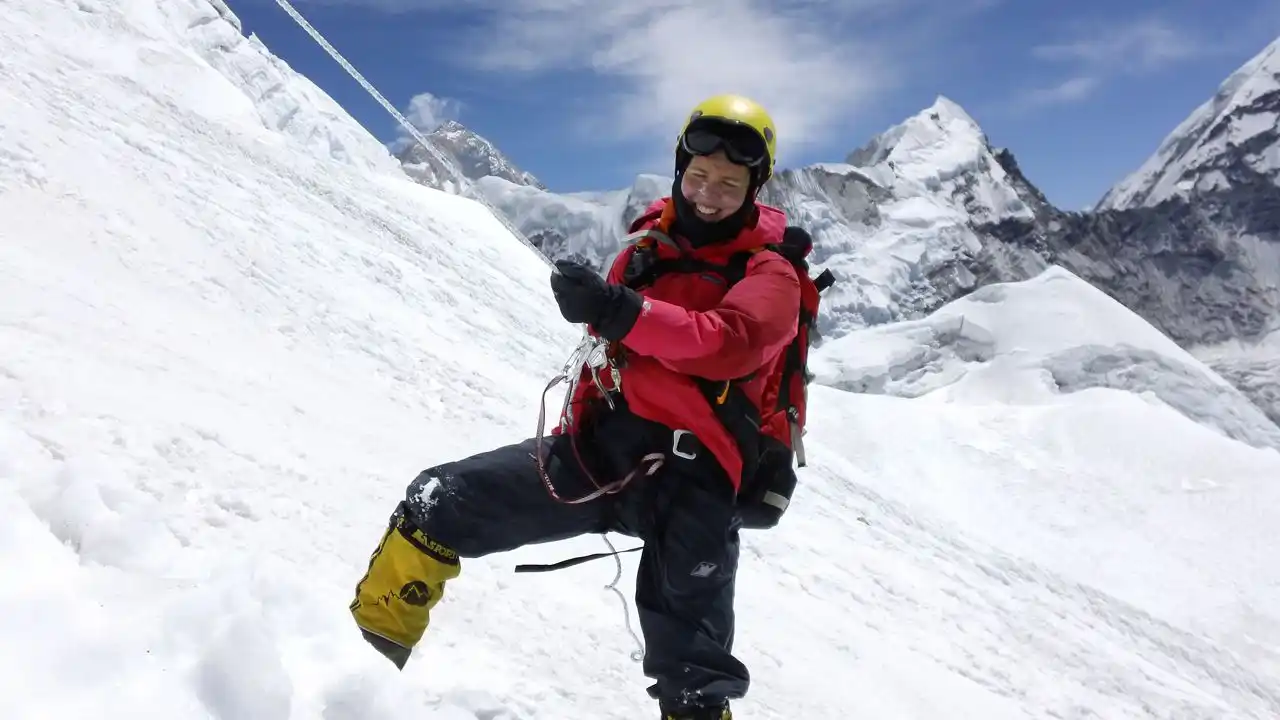
Choosing the Best Time to Climb Island Peak
Deciding the best time to climb Island Peak requires considering your personal preferences for crowd levels, weather conditions, and overall climbing experience. Each season offers distinct advantages and challenges, guiding your selection based on specific requirements.
Evaluate Your Preferences
- Fewer Crowds: Opt for the quieter winter climbing conditions (December to February) and the monsoon season (June to August). These periods feature fewer trekkers but present challenges such as extreme cold and heavy rainfall, which can make the ascent more demanding.
- Optimal Views: For the most spectacular views of Island Peak and the surrounding Himalayas, plan your climb in spring (March to May) or autumn (September to November). These months boast clear skies and stable weather, enhancing visibility. Spring highlights the blooming flora, while autumn offers crisp, clear air following the monsoon.
- Milder Weather: Spring and autumn provide the most comfortable climbing temperatures, making the trek more pleasant. These seasons feature warm days filled with vibrant spring colors or the refreshing coolness of autumn.
- More excellent Solitude: If solitude is what you seek without the extreme conditions, late autumn (November) is ideal. During this time, trekker numbers dwindle, yet you can still enjoy good weather and less crowded paths, allowing a more serene experience.
Permits and Logistics for Climbing Island Peak
Proper preparation is crucial when climbing Island Peak, especially regarding permits and logistics. Seasonal variations significantly influence your planning.
Necessary Permits
- Climbing Permit: You can obtain a climbing permit from the Nepal Mountaineering Association (NMA). The cost varies by season, generally higher during the busy spring and autumn months and lower during the monsoon and winter.
- Sagarmatha National Park Entry Permit: Since Island Peak is within Sagarmatha National Park, an entry permit is required. It can be acquired in Kathmandu or at the park entrance.
- Khumbu Pasang Lhamu Rural Municipality Permit: This permit is mandatory for anyone entering the Khumbu region, covering both Everest Base Camp and Island Peak.
Seasonal Logistics
- Monsoon Season (June to August): Heavy rains during the monsoon season can restrict access to some trails, cause frequent landslides, and create slippery conditions. Be prepared to adjust your plans and pack additional rain gear. Note that some trekking lodges may also close due to reduced visitor numbers.
- Winter Season (December to February): The severe cold and snowfall in winter can complicate access to certain areas. Some lodges and teahouses may close, necessitating planning and confirmation of available accommodations. Always carry appropriate cold-weather gear to cope with challenging conditions.
- Spring and autumn: This peak season for climbing Island Peak offers the best conditions and fully operational trekking routes. Teahouses and lodges are open, providing various services. Due to their popularity, booking your accommodations and flights early is crucial to avoid the inconveniences of overcrowding.
Conclusion: Best Time to Climb Island Peak
Your preferences are vital in choosing the best time to climb Island Peak. Spring and autumn are ideal if you prioritize favorable weather and stunning views. These seasons offer mild temperatures, clear skies, and stable conditions, making them perfect for experienced and novice climbers.
For those who seek solitude and prefer fewer crowds, the winter months (December to February) or the monsoon season (June to August) are better options. However, these seasons bring challenges, such as extreme cold in winter or heavy rainfall during the monsoon. Trekkers in these periods must be well-prepared for more demanding conditions but will enjoy a quieter climbing experience.
Ultimately, the best time to climb Island Peak depends on your personal goals, whether you prefer perfect weather, fewer crowds, or a mix of both. Proper planning and preparation ensure a rewarding and safe climb, regardless of season.


